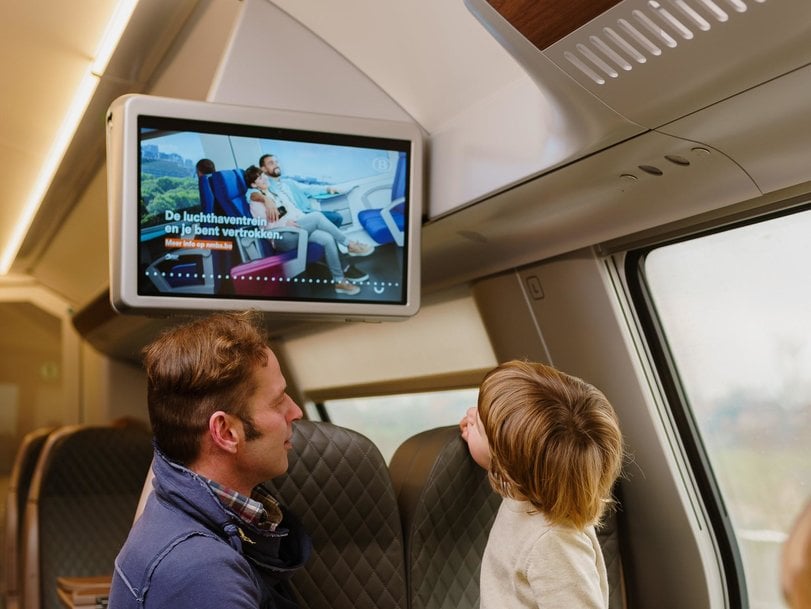railway-international.com
02
'23
Written on Modified on
TELEVIC: How to deliver reliable real-time information on board your rail vehicles?
Easy access to the right information at the right time turns your passengers’ ride into a more enjoyable and reassuring experience.

Whether it's an update about the next stops, arrival times, schedule changes or toilet availability. Televic GSP expert Niels Bouten explains how to broadcast this information on your passenger information systems (PIS) with the Real-time Information Module of LiveCoM Suite.
1. Hop on: what’s the ride?
In the rail industry, real-time information refers to any update available to passengers about their journey, for example approximate locations and estimated arrival times of the vehicles.
Passengers can find that information through the channels you’re providing: from mobile apps, Twitter posts and journey planners to platform information screens and on-board screens and audio messages.
Delivering this information at the right time on the passenger information systems on board of your vehicles, that's where Televic GSP's Real-time Information Management module comes in.
It's a nifty extension you can add to the PIS management software platform LiveCoM Suite which enables these real-time data to flow to your PIS automatically. In doing so, the module makes sure that the information broadcast aboard your vehicles is always up to date and consistent.
2. First stop: where to begin?
First, you need to decide which real-time information you will be sharing on board. Do you simply wish to provide messages regarding the current journey, or also want to show available connections in the next station or add information from a third-party source, for example, to broadcast news flashes or information about rail station facilities.
3. Off we go: how it works
Once the scope of the desired data exchange is determined, our LiveCoM Suite experts will identify which real-time data sources we'll need to connect to your PIS. The best way to ensure a consistent stream of real-time information across channels is through a 'single source of truth': a data source which collects all real-time information and from where these data can trickle down to the relevant broadcasting channels.
If you already have such a single data source in place, our experts will go ahead by mapping its specifications and technical details. To set up the Real-time Information Management module, we'll select and configure just the right connector we need to align your PIS with that data source and allow efficient data exchanges.
To do so, we have multiple connectors available, supporting several data standards, such as GTFS/GTFS-RT, Darwin, multiple ITCS platforms, etc. Are you using a different kind of interface? Then we'll make technical adjustments to establish an equally sound connection.
4. Cow on the line: possible challenge(s)
No connection
What if the connection drops, preventing the latest updates to reach your rail vehicles? Automatic flows in the Real-time Management module ensure that your PIS won’t be showing outdated information.
If the interruption is brief, you may rest assured that the up-to-then known data will still be distributed reliably, as the LiveCoM Suite on-board solution proactively keeps track of all schedules and updates.
Should the connection be lost for, let’s say, 10 minutes, you can decide to broadcasting no or static information only, showing a disclaimer to inform passengers about the connectivity issues.
Software maintenance
Software generally evolves at a much faster pace than your rolling stock. To easily jump the bandwagon on real-time data source and interface enhancements, or to extend your LiveCoM Suite with additional functionalities as you go, we’ve infused our wayside software solution with a data abstraction layer to decouple the external source from our on-board PIS engine.
This way, the interface can be maintained and extended – and evolve at the same pace as your Real-time Management module – with limited impact on your on-board systems.
5. Final destination: the result
By using the Real-time Information module, the passenger information systems in all your rail vehicles are aligned with your single source of truth. The real-time data you're providing across channels is synchronized, enabling you to provide your passengers with reliable up-to-date information at all times.
This enhances your passengers' experience and boosts overall confidence during their journey. Multiple UK studies, conducted by for example Newcastle University and Transport Focus, as the independent watchdog for transport users in the UK, have shown that the availability of up-to-date information aboard the train is one of the key factors impacting overall passenger satisfaction, after punctuality and level of crowding on the train.
www.televic.com

